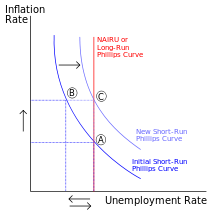Thermoeconomics
| Economics |
|---|
 Phillips curve graph, illustrating an economic principle |
|
|
| By application |
|
| Lists |
|

Thermoeconomics, also referred to as biophysical economics, is a school of heterodox economics that applies the laws of thermodynamics to economic theory.[2] The term "thermoeconomics" was coined in 1962 by American engineer Myron Tribus,[3][4][5] Thermoeconomics can be thought of as the statistical physics of economic value.[6]
Basis
Thermoeconomics is based on the proposition that the role of energy in biological evolution should be defined and understood not through the second law of thermodynamics but in terms of such economic criteria as productivity, efficiency, and especially the costs and benefits (or profitability) of the various mechanisms for capturing and utilizing available energy to build biomass and do work.[7][8]
Thermodynamics
Thermoeconomists maintain that human economic systems can be modeled as thermodynamic systems. Then, based on this premise, theoretical economic analogs of the first and second laws of thermodynamics are developed.[9] In addition, the thermodynamic quantity exergy, i.e. measure of the useful work energy of a system, is one measure of value..
Alternately, the existence of thermodynamic correspondences arises directly (i.e., is not a-priori constructed) in bounded-rational potential games in two different ways: from a dynamical equilibrium or from a constrained maximum information-entropy equilibrium,.[10][11]
Economic systems
Thermoeconomists argue that economic systems always involve matter, energy, entropy, and information.[12] Moreover, the aim of many economic activities is to achieve a certain structure. In this manner, thermoeconomics applies the theories in non-equilibrium thermodynamics, in which structure formations called dissipative structures form, and information theory, in which information entropy is a central construct, to the modeling of economic activities in which the natural flows of energy and materials function to create scarce resources.[2] In thermodynamic terminology, human economic activity may be described as a dissipative system, which flourishes by consuming free energy in transformations and exchange of resources, goods, and services.[13][14]
See also
- Econophysics
- Ecodynamics
- Kinetic exchange models of markets
- Systems ecology
- Ecological economics
- Nicholas Georgescu-Roegen
References
- ↑ A. Müller, L. Kranzl, P. Tuominen, E. Boelman, M. Molinari, A.G. Entrop: Estimating exergy prices for energy carriers in heating systems: Country analyses of exergy substitution with capital expenditures. Energy and Buildings, Volume 43, Issue 12, December 2011, Pages 3609–3617.
- 1 2 Sieniutycz, Stanislaw; Salamon, Peter (1990). Finite-Time Thermodynamics and Thermoeconomics. Taylor & Francis. ISBN 0-8448-1668-X.
- ↑ Yehia M. El-Sayed (2003). The Thermoeconomics of Energy Conversions (pg. 4). Pergamon.
- ↑ A. Valero, L. Serra, and J. Uche (2006). Fundamentals of Exergy Cost Accounting and Thermoeconomics. Part I: Theory, Journal of Energy Resources Technology, Volume 128, Issue 1, pp. 1-8.
- ↑ Gong, Mei, Wall, Goran. (1997). On Exergetics, Economics and Optimization of Technical Processes to Meet Environmental Conditions. Exergy Studies.
- ↑ Chen, Jing (2005). The Physical Foundation of Economics - an Analytical Thermodynamic Theory. World Scientific. ISBN 981-256-323-7.
- ↑ Peter A. Corning 1*, Stephen J. Kline. (2000). Thermodynamics, information and life revisited, Part II: Thermoeconomics and Control information Systems Research and Behavioral Science, Apr. 07, Volume 15, Issue 6 , Pages 453 – 482
- ↑ Corning, P. (2002). “Thermoeconomics – Beyond the Second Law”
- ↑ Burley, Peter; Foster, John (1994). Economics and Thermodynamics – New Perspectives on Economic Analysis. Kluwer Academic Publishers. ISBN 0-7923-9446-1.
- ↑ Campbell, Michael J. (2005). "A Gibbsian approach to potential game theory (draft)". arXiv:cond-mat/0502112v2
 .
.
- ↑ Carfi, David; Campbell, Michael J. (2015). "Bounded Rational Speculative and Hedging Interaction Model in Oil and U.S. Dollar Markets". Journal of Mathematical Economics and Finance. ASERS. 1 (1): 4–23. doi:10.14505/jmef.01.
- ↑ Baumgarter, Stefan. (2004). Thermodynamic Models, Modeling in Ecological Economics (Ch. 18)
- ↑ Raine, Alan; Foster, John; Potts, Jason (2006). "The new entropy law and the economic process". Ecological Complexity. 3: 354–360. doi:10.1016/j.ecocom.2007.02.009.
- ↑ Annila, A. and Salthe, S., Arto; Salthe, Stanley (2009). "Economies evolve by energy dispersal". Entropy. 11 (4): 606–633. doi:10.3390/e11040606.
Further reading
- Soddy, Frederick (1922). Cartesian Economics: The Bearing of Physical Science upon State Stewardship. London: Hendersons.
- Georgescu-Roegen, Nicholas (1971). The Entropy Law and the Economic Process. Cambridge, Massachusetts: Harvard University Press. ISBN 978-1583486009.
- El-Sayed, Yehia, M. (2003). The Thermoeconomics of Energy Conversions. Pergamon. ISBN 0-08-044270-6.
- Pokrovskii, Vladimir (2011). Econodynamics. The Theory of Social Production. Berlin: Springer. ISBN 978-1-4419-9364-9.
- Kümmel, Reiner (2011). The Second Law of Economics: Energy, Entropy, and the Origins of Wealth. Berlin: Springer. ISBN 978-94-007-2095-4.
- Valero Capilla, Antonio; Alicia Valero Delgado (2014). Thanatia: The Destiny of the Earth's Mineral Resources: A Thermodynamic Cradle-to-Cradle Assessment. Singapore: World Scientific. ISBN 978-981-4273-93-0.
- Chen, Jing (2015). The Unity of Science and Economics: A New Foundation of Economic Theory. http://www.springer.com/us/book/9781493934645: Springer.
External links
- Yuri Yegorov, article Econo-physics: A Perspective of Matching Two Sciences, Evol. Inst. Econ. Rev. 4(1): 143–170 (2007) _pdf (application/pdf Object)
- Borisas Cimbleris (1998): Economy and Thermodynamics
- Schwartzman, David. (2007). "The Limits to Entropy: the Continuing Misuse of Thermodynamics in Environmental and Marxist theory", In Press, Science & Society.
- Saslow, Wayne M. (1999). "An Economic Analogy to Thermodynamics" American Association of Physics Teachers.
